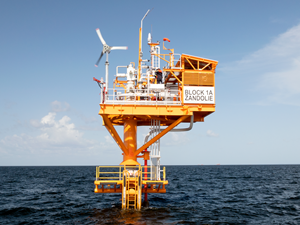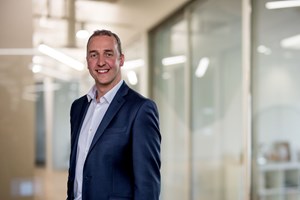Offshore Europe: Aquaterra Energy takes a multi-track approach to upcoming business
(What follows is another segment of World Oil’s extended coverage of topics, speakers and companies at Offshore Europe, held Sept. 5-8.)
At Offshore Europe last week, much was said about traditional oil-and-gas-related firms expanding or transitioning into equipment and services for renewable energies, including offshore wind, CCS and hydrogen. While some companies are abandoning oil and gas, others continue to see it as a primary business line, complemented by additional businesses in renewables. They have no plans to shrink or eliminate oil and gas from their activities. At the forefront of this latter group is Aquaterra Energy. What follows is a special interview with the firm’s Managing Director, James Larnder, who discusses his company’s philosophy, current business and plans for the future.
World Oil (WO): Delving right into some of the headline topics at Offshore Europe this year, would you say that your firm is de-emphasizing traditional oil and gas business in favor of renewable projects like CCS?
James Larnder (JL): No, not at all. My goal is to make sure our business is still nimble, and I can adapt to change. I think that change is happening, and not just in our heritage oil and gas business. That's where the business started, and that's where the business will stay, predominantly. We'll still be in oil and gas, but adapting our business right across the energy sector. And that's what our strategy has spent the last couple of years doing.
We're fortunate in that we have a lot of products, services, and core engineering expertise that's directly translatable into the energy transition. We've talked the talk, and now we're walking the walk in what we're doing. We were very conscious—we didn't want to just have a greenwashing exercise. We wanted to be credible in what we're doing. It's not only about us supporting the decarbonization of the oil and gas sector that we're operating in, it’s also about moving into the energy transition space, especially carbon capture and storage and green hydrogen.
Carbon capture and storage for us is happening a lot quicker—it's a lot closer to the boat. We're involved in real projects and now starting to deploy our engineering resources into green hydrogen. Our renewables director is giving a speech [at Offshore Europe] on green hydrogen. So, that is a very, very exciting time and opportunity for us as a business. We're steering our Aquaterra Energy ship into the energy transition space.
WO: And you’re doing this while still maintaining the heritage oil and gas work.
JL: It’s not going anywhere. I would say, if you asked me this question last year, the kind of media response, the industry response, was very downbeat on oil and gas. I think that the situation is changing now, when you combine the need for energy security, particularly here in the UK, with the realization that hydrocarbons will continue to be part of the mix way beyond 2050. It's about what we can do as a business to help support that. We need hydrocarbons, so let's do it as efficiently as we can.
We've turned our attention to—if I can turn the clock back to the start of Aquaterra—we were very much focused on efficiencies and cost-savings for our customers, and that still is the case. We still need to be cost-efficient. But equally now, those cost-savings are manifesting themselves in carbon savings. Compared to when I used to talk about only the dollar signs and the dollar savings amounts, I’m now also talking about CO2 savings. For example, if we can design and build a platform that uses 30% less steel, yes, you will save cost, but you're also, therefore, reducing the overall carbon footprint. Likewise, if we can do away with the diesel power generation on the platform and power it by renewables, we again reap the carbon footprint savings.
WO: From a technical standpoint, what are some of the projects you're working on now? Are there any new innovations?
JL: Right across our business lines, technical innovation is key. Some examples are renewably powered small platforms, Fig. 1. Like I say, taking advantage of powering the entire platform 100% by renewables, coupled with that platform using less steel than traditional platforms. A range of new AQC Riser Systems enabling jackup drilling and intervention of subsea wells and completion and workover operation from all offshore vessel types. So, a more innovative, bespoke approach.

WO: So, how are you achieving the platform steel savings?
JL: Instead of the traditional approach of maybe taking an off-the-shelf platform design, I'm actually thinking, “well, tell me about this particular project, and I will design a modular platform to suit it.” Therefore, I'm using less steel. For example, we will construct a conductor-supported platform that uses the well conductors as the legs of the platform. Therefore, I don't have need for a much bigger jacket structure. That's how I save the steel.
I install that platform with a jackup drilling rig that's already on location, so I don't have a need to mobilize a heavy lift vessel. Again, I'm saving dollars and I'm saving the need for that vessel and its carbon footprint. So, that's innovation. In new riser systems, we have an AQC-SR range of risers, and we’re now delivering those. We've been working on those for the last five years, and we're now releasing them back to the market.
That's a high-pressure riser system, up to 15,000 psi. And what does that do? Well, that allows you to drill into subsea wells from a jackup drilling rig, instead of a semi-submersible. Traditionally, one would use a semi for a subsea well, so this enables you to utilize a much cheaper jackup rig. Obviously, that is done within the constraints of water depth. So, you're still in the jackup water depths. But a lot of our business is focused around shallow-water jackup drilling. And that's what the industry is demanding right now.
WO: That's certainly true in the Middle East.
JL: Most definitely. Rig utilizations are back up to pre-pandemic levels. That's a big region for us. We've got projects ongoing at the moment. For example, again, using our AQC riser system, an operator had a project where the traditional way of intervening and decommissioning those wells wasn’t working. So, they came to us for our expertise in riser systems and how to handle the riser systems from a jackup, so they can use one of their existing fleet to intervene and ultimately decommission those wells.
WO: Are there other items, in particular, on the technology front?
JL: Other than riser systems and utilizing modular types of platforms, we’re moving riser systems into the energy transition space. So, utilizing heritage well re-entry expertise in carbon capture and storage wells. A big question mark is the safety around existing wells and a carbon capture and storage site. One needs to re-enter those wells to ensure they have been abandoned correctly and to ensure the required pressures that the carbon capture and storage project may require. First, you need to find those old wells that may have been drilled back in the 1980s or before, and then you need to re-enter those wells. You need to support the loads in those wells, and that's where our expertise comes in.
That technology will support the well and loads, so you can safely re-enter the well and abandon it, should that be required. Then, you can also use that to deploy a monitoring system. Monitoring of these wells is obviously going to be very important, not only from a baseline point of view, but to ensure the CO2 is basically being deployed into the reservoir, as planned.
So, two product lines there for us—well, re-entry support and monitoring of CO2. So again, it's using existing knowledge, existing expertise, existing engineering, and some existing equipment. But, deploying it into carbon capture and storage.
WO: Your company seems to have done a good job in spreading your activity just enough while still giving sufficient effort to each business line. Thus, if some market force causes one line to be diminished for a while, you’ve still got plenty of other ways to earn revenue.
JL: Yeah, definitely. And our whole business is based on innovation. We're an innovation led business. Always have been. It's about understanding the customer and the project requirements and finding solutions to those requirements. As a result of that, we innovate to come up with new products, new services to fill that gap, and then look to take those products to market. That's been the DNA of our business.
WO: What do you think some of your biggest challenges are at this point?
JL: The biggest challenge for us is a lot of supply chain constraints at the moment. The supply chain is very busy as a result of both an industry downturn, a Covid downturn, and now there's a demand for very rapid oil and gas returns. People want things quickly, so supply chain constraints are the biggest challenge. Also, we're a growing business, and we need to add resources to our business. There's been an exodus of people from our industry, as a result of downturn and Covid. So, finding good-quality people to help grow our business is another challenge.
WO: Everybody has a problem with having enough people.
JL: Exactly. So, what do we do about it? Well, we try and grow our own. We've carried on, taking on graduates. We took on five last year. We'll take on another five this year, supplementing them with interns and apprentices. We're not only taking on senior experienced people, we're trying to grow that resource.
WO: Hopefully, they appreciate that you're putting the effort into them and some money, obviously. And they'll say, “they're investing in me and they're trying to pull me along, so I ought to be dedicated to them.”
JL: That's the plan. And it works for us. I'm an example of somebody who stayed with the business for a long time and has grown up through that business.
WO: Not to simplify things, but if you could put into percentage terms how much of your business is heritage oil and gas? How much is, say, related to CCS and hydrogen?
JL: In terms of number of projects, we're probably about 90% oil and gas. So, we're very much oil and gas, and then everything else is energy transition. And I can see that growing. That will certainly be growing, but equally, I'm not going to lie and say it will flip, because I see a lot of oil and gas projects in our pipeline. It's at the core of our business, and it will stay that way for a few years. But, certainly we’re branching out into new energy sectors.
From an energy transition standpoint, it’s incredibly important for us and has been one of our key strategies over the last couple of years. We will be continuing with our innovation-led approach. We have an innovation director, who is specifically assigned to developing those new products, those new services within our business. We will be having riser systems in carbon capture and storage. We will be deploying systems and engineering in the green hydrogen space. We will be releasing the carbon capture and storage monitoring systems into the marketplace, likely next year.



